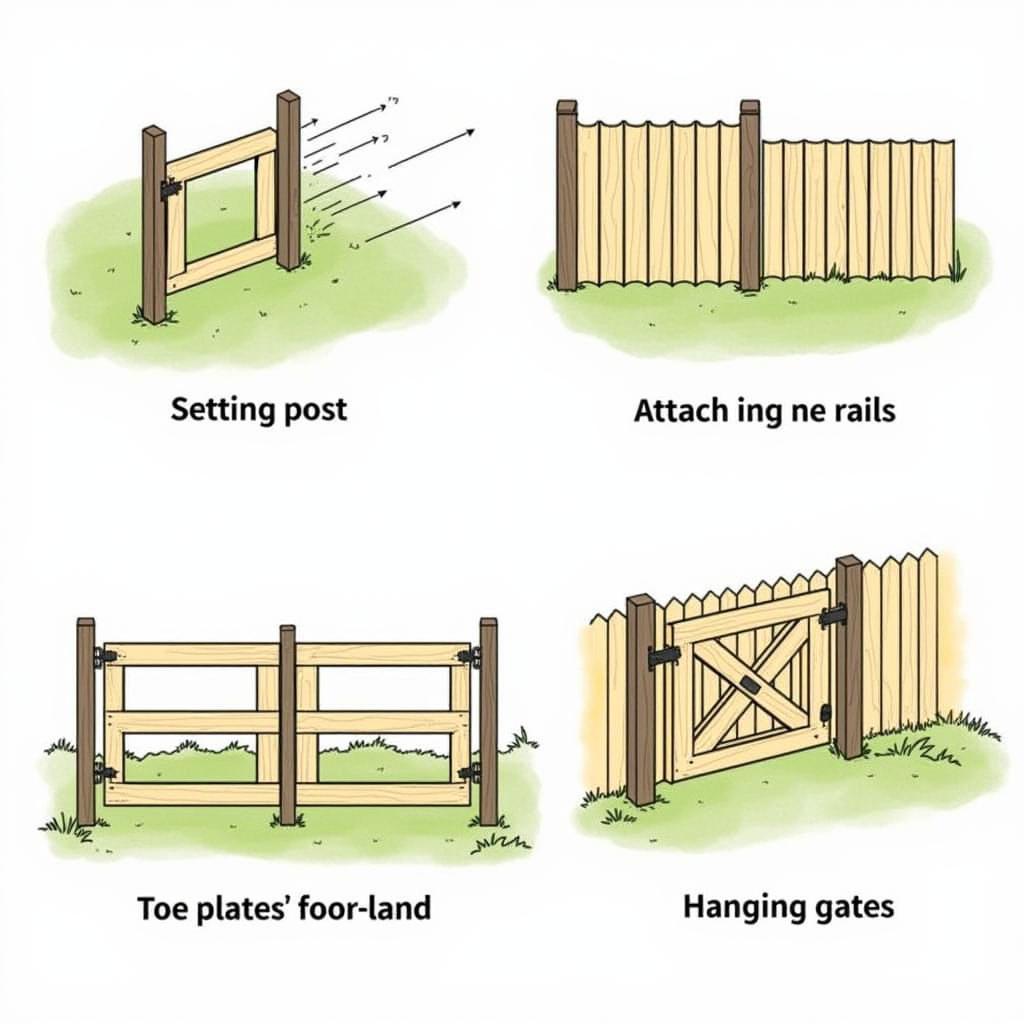Four Board Horse Fence is a popular choice for horse owners seeking a balance of aesthetics, safety, and functionality. This classic fencing option offers a timeless appeal while providing a secure enclosure for your equine companions. Whether you’re establishing a new pasture or upgrading your existing fencing, understanding the ins and outs of four board horse fence is crucial. This comprehensive guide will delve into everything you need to know about four board horse fence, from its advantages and considerations to installation and maintenance tips.
Why Choose Four Board Horse Fence?
Four board horse fence offers a myriad of benefits that make it a top contender for horse owners:
- Visibility and Safety: The open design of a four board fence allows horses to see their surroundings clearly, reducing the risk of injuries from spooking or running into the fence.
- Strength and Durability: Constructed from sturdy materials like wood or vinyl, four board fences are built to withstand the rigors of horse activity.
- Aesthetic Appeal: The classic, clean lines of a four board fence enhance the beauty of any property, blending seamlessly with both rural and more developed landscapes.
- Cost-Effectiveness: Compared to other specialized horse fencing options, four board fencing can offer a more budget-friendly solution.
Factors to Consider When Choosing a Four Board Horse Fence
Before you install your four board horse fence, it’s essential to evaluate several factors that will impact its effectiveness and longevity:
1. Material Selection: Wood vs. Vinyl
-
Wood: Traditional wooden fences offer a natural look and are generally more affordable upfront. Opt for pressure-treated lumber to resist rot and insect damage.
-
Vinyl: Vinyl fencing is gaining popularity for its durability, low maintenance requirements, and resistance to fading, warping, and pests. While initially more expensive, vinyl can offer long-term cost savings.
2. Post Selection and Spacing:
-
Posts: Sturdy posts are the backbone of your fence. Choose pressure-treated wood posts or galvanized steel posts for maximum strength.
-
Spacing: Posts should be spaced 8-12 feet apart to provide adequate support for the rails. Closer spacing may be necessary in areas with high wind or uneven terrain.
3. Height and Rail Configuration:
-
Height: A standard four board horse fence is typically 48-54 inches tall, sufficient to deter most horses from jumping or leaning over.
-
Rails: The horizontal rails should be securely attached to the posts. You can opt for a traditional four-rail design or add a fifth rail for increased security.
4. Gate Placement and Hardware:
-
Gates: Strategically placed gates allow easy access to pastures and paddocks. Choose durable gates with secure latches designed specifically for horses.
-
Hardware: Use high-quality, galvanized hardware to prevent rust and ensure the longevity of your fence.
Installing Your Four Board Horse Fence: Key Steps for Success
Proper installation is crucial for a safe and long-lasting four board horse fence. Follow these key steps:
-
Planning and Layout: Carefully plan the fence line, marking out gate locations and considering terrain variations.
-
Setting Posts: Dig holes at least 2-3 feet deep for each post, ensuring they are plumb and secure. Backfill with compacted gravel or concrete for added stability.
-
Attaching Rails: Securely fasten the horizontal rails to the posts using appropriate hardware, ensuring they are level and evenly spaced.
-
Hanging Gates: Hang gates with sturdy hinges and secure latches that are horse-proof.
-
Finishing Touches: Inspect the entire fence for any sharp edges or protrusions and make necessary adjustments. Apply a sealant or paint to wooden fences for added protection.
 Installing a Four Board Horse Fence
Installing a Four Board Horse Fence
Maintaining Your Four Board Horse Fence: Tips for Longevity
Regular maintenance will help your four board horse fence stand the test of time:
-
Inspections: Inspect your fence regularly for signs of damage, such as loose boards, rotting wood, or broken hardware. Address any issues promptly.
-
Cleaning: Remove debris, manure, and vegetation that can accumulate along the fence line.
-
Repairs: Repair any damaged boards, posts, or hardware as needed.
-
Wood Treatment: Reapply sealant or paint to wooden fences every few years to protect against the elements.
FAQs about Four Board Horse Fence
-
How much does four board horse fence cost? The cost varies depending on materials, labor, and location. However, it generally ranges from $15 to $30 per linear foot.
-
Is a four board fence strong enough for horses? Yes, when properly constructed with sturdy materials and secure hardware, a four board fence provides adequate containment for most horses.
-
Can I install a four board horse fence myself? DIY installation is possible with the right tools and experience. However, for larger projects or complex terrain, professional installation is recommended.
Need Help with Your Horse Fencing Needs?
Contact Justus Horses USA! We’re dedicated to providing top-quality horse care resources and services. Call us at 0772127271, email us at [email protected], or visit our location at QGM2+WX2, Vị Trung, Vị Thuỷ, Hậu Giang, Việt Nam. We’re here for all your horse boarding Des Moines Iowa needs.